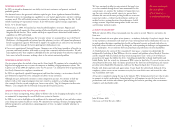Aetna 2004 Annual Report Download - page 14
Download and view the complete annual report
Please find page 14 of the 2004 Aetna annual report below. You can navigate through the pages in the report by either clicking on the pages listed below, or by using the keyword search tool below to find specific information within the annual report.
25
Pay for Performance: Potential
Impact and Implementation Strategies
THOMAS H. LEE, M.D.
Network President, Partners HealthCare System, and
Professor of Medicine, Harvard Medical School
Just a few years ago, “pay-for-performance” contracting was an
experiment in which physicians in Massachusetts and California
were offered modest incentives if they could improve quality and
efficiency. Now, insurers throughout the country and Medicare
are testing the concept, even as they wonder whether pay for
performance is more hype than hope.
One reason for the uncertainty is that so many versions of pay for
performance have emerged – and hardly any have been around
long enough to be evaluated. In 2003, Aetna and five other
insurers began paying an estimated $50 million per year in
bonuses to California physicians for improving quality. Similar
programs emerged in Boston around the same time.
In general, these pay-for-performance contracts target three key
areas. Clinical quality goals include higher rates of preventive care (e.g., mammography) and other
proven interventions (e.g., eye examinations for diabetics). Efficiency goals focus on reducing
unnecessary hospital admissions, and improving the cost-effectiveness of pharmacy prescribing and
radiology test ordering.
The third – and most controversial – common theme of pay-for-performance contracts is adoption
of electronic health records (EHRs) to help physicians keep track of patients, and order the right
drugs and tests. Why the controversy? Employers who are funding the bonuses wonder if EHRs
really help control costs. Meanwhile, physicians complain that the bonuses are insufficient to cover
the costs of these systems, which can exceed $25,000 per physician in the first year.
Nevertheless, pay for performance is gaining momentum, and early experience from California and
Boston suggests that physicians are responding. They are buying EHRs, improving their diabetes
care – and often practicing more efficiently. Many physicians say they like the concept of bonuses
for better clinical quality and understand that improvements in efficiency are necessary to keep such
incentive programs alive.
As the years go by, the targets of pay-for-performance contracts are getting tougher. To meet these
goals, physicians are realizing that they need to embrace two revolutions. The first is an industrial
revolution in which physicians adopt systems such as EHRs that improve quality and efficiency.
The second is a cultural revolution in which physicians recognize that they are members of teams
that care for populations of patients over time – not just when they are in the hospital or the
doctor’s office.
The true impact of pay for performance may take years to discern, but these contracts seem to be
driving the adoption of the systems needed to re-engineer health care – and provide the improvements
in quality and efficiency we so desperately need.
In 2003, Aetna and
five other insurers
began paying an
estimated $50 million
per year in bonuses to
California physicians
for improving quality.
























